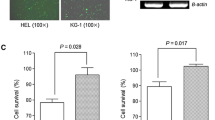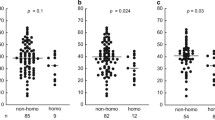Abstract
Imatinib mesylate (IM), a well-established gold standard drug in the treatment of chronic myeloid leukaemia (CML), is a synthetic tyrosine kinase inhibitor. Despite excellent efficacy, a significant number of patients on IM therapy develop resistance to IM. Currently, great focus has been laid on the effect of interindividual pharmacogenetic variability on IM treatment responses. IM uptake is mediated by the hOCT1 protein encoded by the solute carrier 22 gene (SLC22A1). The current study investigated the impact of few single-nucleotide polymorphisms (SNPs) of SLC22A1 on mediating resistance and/or good response to IM among 278 Malaysian CML patients (146 IM-resistant group and 132 IM good response group) undergoing IM therapy on 400 mg daily. Our results showed that the allelic frequencies of heterozygous (CG) and homozygous variant (GG) genotypes of SLC22A1 C480G were significantly higher in the IM-resistant group compared with the IM good response group (41.8% versus 30.3% and 10.9% versus 4.5% with P values of 0.047 and 0.048, respectively). On evaluating the association of genotypes with risk of IM resistance development, heterozygous (CG) and homozygous (GG) variant genotypes showed significantly higher risk for developing resistance to IM treatment with odds ratio (OR): 1.901 (95% confidence interval (CI): 1.142–3.163, \(P=0.013\)) and 3.324 (95% CI: 1.235–8.947, \(P=0.017\)), respectively. Two SNPs and two insertions/deletions were detected in exon 7 of SLC22A1. For exon 7, 1222AA carriers together with the presence of both the 8-bp insertion and 3-bp deletion, and M420del alleles showed higher possibility of developing resistance towards IM treatment. Our results warrant the need of genotyping this SNP in terms of modulating IM treatment in CML patients.



Similar content being viewed by others
References
Angelini S., Soverini S., Ravegnini G., Barnett M., Turrini E., Thornquist M. et al. 2013 Association between imatinib transporters and metabolizing enzymes genotype and response in newly diagnosed chronic myeloid leukemia patients receiving imatinib therapy. Haematologica 98, 193–200.
Baccarani M., Pileri S., Steegmann J. L., Muller M., Soverini S. and Dreyling M. 2012 Chronic myeloid leukemia: ESMO clinical practice guidelines for diagnosis, treatment and follow-up. Ann. Oncol. 23, vii72–77.
Bazeos A., Marin D., Reid A. G., Gerrard G., Milojkovic D., May P. C. et al. 2010 hOCT1 transcript levels and single nucleotide polymorphisms as predictive factors for response to imatinib in chronic myeloid leukemia. Leukemia 24, 1243–1245.
Bixby D. and Talpaz M. 2009 Mechanisms of resistance to tyrosine kinase inhibitors in chronic myeloid leukemia and recent therapeutic strategies to overcome resistance. Hematol. Am. Soc. Hematol. Educ. Program, 461–476.
Cao C., Li X., Liu T., Zhang L., Shen K. and Zhu H. 2015 Human organic cation transporter 1 protein levels of granulocytes can optimize imatinib therapy in patients with chronic myeloid leukemia. Acta Haematol. 133, 199–204.
Carella A. M. 2007 Imatinib mesylate, a selective inhibitor of BCR–ABL, in chronic myeloid leukemia. Expert Rev. Anticancer Ther. 7, 249–251.
Cervantes F. and Mauro M. 2011 Practical management of patients with chronic myeloid leukemia. Cancer 117, 4343–4354.
Giannoudis A., Wang L., Jorgensen A. L., Xinarianos G., Davies A., Pushpakom S. et al. 2013 The hOCT1 SNPs M420del and M408 V alter imatinib uptake and M420del modifies clinical outcome in imatinib-treated chronic myeloid leukemia. Blood 121, 628–637.
Grinfeld J., Gerrard G., Alikian M., Alonso-Dominguez J., Ale S., Valgañon M. et al. 2013 A common novel splice variant of SLC22A1 (OCT1) is associated with impaired responses to imatinib in patients with chronic myeloid leukaemia. Br. J. Haematol. 163, 631–639.
Itoda M., Saito Y., Maekawa K., Hichiya H., Komamura K., Kamakura S. et al. 2004 Seven novel single nucleotide polymorphisms in the human SLC22A1 gene encoding organic cation transporter 1 (OCT1). Drug Metab. Pharmacokinet. 19, 308–312.
Kim D. H., Sriharsha L., Xu W., Kamel-Reid S., Liu X., Siminovitch K. et al. 2009 Clinical relevance of a pharmacogenetic approach using multiple candidate genes to predict response and resistance to imatinib therapy in chronic myeloid leukemia. Clin. Cancer Res. 15, 4750–4758.
Marin D., Bazeos A., Mahon F. X., Eliasson L., Milojkovic D., Bua M. et al. 2010 Adherence is the critical factor for achieving molecular responses in patients with chronic myeloid leukemia who achieve complete cytogenetic responses on imatinib. J. Clin. Oncol. 28, 2381–2388.
Marin D., Hedgley C., Clark R. E., Apperley J., Foroni L., Milojkovic D. et al. 2012 Predictive value of early molecular response in patients with chronic myeloid leukemia treated with first-line dasatinib. Blood 120, 291–294.
O’Brien S. G. and Deininger M. W. 2003 Imatinib in patients with newly diagnosed chronic phase chronic myeloid leukemia. Semin. Hematol. 40, 26–30.
Shu Y., Brown C., Castro R. A., Shi R. J., Lin E. T. and Owen R. P. 2008 Effect of genetic variation in the organic cation transporter 1, OCT1, on metformin pharmacokinetics. Clin. Pharmacol. Ther. 83, 273–280.
Singh O., Chan J. Y., Lin K., Heng C. C. T. and Chowbay B. 2012 SLC22A1-ABCB1 haplotype profiles predict imatinib pharmacokinetics in Asian patients with chronic myeloid leukemia. PLoS One 7, e51771.
Takahashi N., Miura M., Scott S. A., Kagaya H., Kameoka Y., Tagawa H. et al. 2010 Influence of CYP3A5 and drug transporter polymorphisms on imatinib trough concentration and clinical response among patients with chronic phase chronic myeloid leukemia. J. Hum. Genet. 55, 731–737.
Thomas J., Wang L., Clark R. E. and Pirmohamed M. 2004 Active transport of imatinib into and out of cells: implications for drug resistance. Blood 104, 3739–3745.
Vaidya S., Ghosh K., Shanmukhaiah C. and Vundinti B. R. 2015 Genetic variations of hOCT1 gene and CYP3A4/A5 genes and their association with imatinib response in chronic myeloid leukemia. Eur. J. Pharmacol. 765, 124–130.
Wang L., Giannoudis A., Lane S., Williamson P., Pirmohamed M. and Clark R. 2008 Expression of the uptake drug transporter hOCT1 is an important clinical determinant of the response to imatinib in chronic myeloid leukemia. Clin. Pharmacol. Ther. 83, 258–264.
White D. L., Saunders V. A., Dang P., Engler J., Zannettino A. C., Cambareri A. C. et al. 2006 OCT-1-mediated influx is a key determinant of the intracellular uptake of imatinib but not nilotinib (AMN107): reduced OCT-1 activity is the cause of low in vitro sensitivity to imatinib. Blood 108, 697–704.
White D. L., Saunders V. A., Dang P., Engler J., Venables A., Zrim S. et al. 2007 Most CML patients who have a suboptimal response to imatinib have low OCT-1 activity: higher doses of imatinib may overcome the negative impact of low OCT-1 activity. Blood 110, 4064–4072.
Acknowledgements
This study was supported by USM APEX grant no. 1002/PPSP/910340. The cooperation of Dr Ai Sim Goh (Hospital Pulau Pinang), Dr Padmini Menon (Hospital Ipoh), Dr Chew Teng Keat (Hospital Kuching) Prof. Rosline Hassan (Universiti Sains Malaysia), Prof. S. A. W. Fadilah (UKM Medical Center) and Dr Alan Teh (Sime Darby Medical Center) in patient recruitment is gratefully acknowledged.
Author information
Authors and Affiliations
Corresponding author
Additional information
Corresponding editor: Dhavendra Kumar
Rights and permissions
About this article
Cite this article
Makhtar, S.M., Husin, A., Baba, A.A. et al. Genetic variations in influx transporter gene SLC22A1 are associated with clinical responses to imatinib mesylate among Malaysian chronic myeloid leukaemia patients. J Genet 97, 835–842 (2018). https://doi.org/10.1007/s12041-018-0978-9
Received:
Accepted:
Published:
Issue Date:
DOI: https://doi.org/10.1007/s12041-018-0978-9




